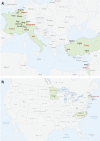The Rare Cancer Network: achievements from 1993 to 2012
- PMID: 23087791
- PMCID: PMC3475942
- DOI: 10.4081/rt.2012.e35
The Rare Cancer Network: achievements from 1993 to 2012
Abstract
The Rare Cancer Network (RCN), founded in 1993, performs research involving rare tumors that are not common enough to be the focus of prospective study. Over 55 studies have either been completed or are in progress.The aim of the paper is to present an overview of the 30 studies done through the RCN to date, organized by disease site. Five studies focus on breast pathology, including sarcoma, lymphoma, phyllodes tumor, adenoid cystic carcinoma, and ductal carcinoma in situ in young women. Three studies on prostate cancer address prostatic small cell carcinoma and adenocarcinoma of young and elderly patients. Six studies on head and neck cancers include orbital and intraocular lymphoma, mucosal melanoma, pediatric nasopharyngeal carcinoma, olfactory neuroblastoma, and mucosa-associated lymphoid tissue lymphoma of the salivary glands. There were 4 central nervous system studies on patients with cerebellar glioblastoma multiforme, atypical and malignant meningioma, spinal epidural lymphoma and myxopapillary ependymoma. Outside of these disease sites, there is a wide variety of other studies on tumors ranging from uterine leiomyosarcoma to giant cell tumors of the bone. The studies done by the RCN represent a wide range of rare pathologies that were previously only studied in small series or case reports. With further growth of the RCN and collaboration between members our ability to analyze rare tumors will increase and result in better understanding of their behavior and ultimately help direct research that may improve patient outcomes.
Keywords: oncology; radiotherapy.; rare; tumors.
Conflict of interest statement
Conflict of interests: the authors declare no potential conflict of interests.
Figures
References
-
- Omlin A, Amichetti M, Azria D, et al. Boost radiotherapy in young women with ductal carcinoma in situ: a multicentre, retrospective study of the Rare Cancer Network. Lancet Oncol. 2006;7:652–6. - PubMed
-
- Bousquet G, Confavreux C, Magne N, et al. Outcome and prognostic factors in breast sarcoma: a multicenter study from the rare cancer network. Radiother Oncol. 2007;85:355–61. - PubMed
-
- Belkacemi Y, Bousquet G, Marsiglia H, et al. Phyllodes tumor of the breast. Int J Radiat Oncol Biol Phys. 2008;70:492–500. - PubMed
-
- Khanfir K, Kallel A, Villette S, et al. Management of adenoid cystic carcinoma of the breast: a Rare Cancer Network Study. Int J Radiat Oncol Biol Phys. 2012;82:2118–24. - PubMed
LinkOut - more resources
Full Text Sources
Miscellaneous


